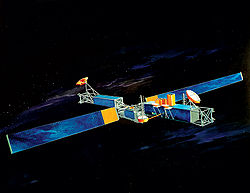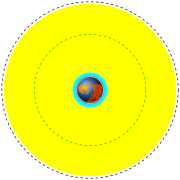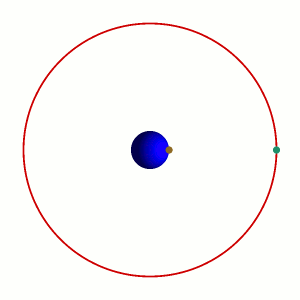Communications satellite
From Wikipedia, the free encyclopedia

A communications satellite (sometimes abbreviated to SATCOM) is an artificial satellite stationed in space for the purposes of telecommunications. Modern communications satellites use a variety of orbits including geostationary orbits, Molniya orbits, other elliptical orbits and low (polar and non-polar) Earth orbits.
For fixed (point-to-point) services, communications satellites provide a microwave radio relay technology complementary to that of submarine communication cables. They are also used for mobile applications such as communications to ships, vehicles, planes and hand-held terminals, and for TV and radio broadcasting, for which application of other technologies, such as cable, is impractical or impossible.
Contents |
[edit] History
See: Geostationary Orbit and Geosynchronous orbit Satellites.
[edit] Early missions
The first artificial satellite was the Soviet Sputnik 1, launched on October 4, 1957, and equipped with an on-board radio-transmitter that worked on two frequencies, 20.005 and 40.002 MHz. The first American satellite to relay communications was Project SCORE in 1958, which used a tape recorder to store and forward voice messages. It was used to send a Christmas greeting to the world from U.S. President Dwight D. Eisenhower. NASA launched an Echo satellite in 1960; the 100-foot aluminized PET film balloon served as a passive reflector for radio communications. Courier 1B, built by Philco, also launched in 1960, was the world’s first active repeater satellite.
Telstar was the first active, direct relay communications satellite. Belonging to AT&T as part of a multi-national agreement between AT&T, Bell Telephone Laboratories, NASA, the British General Post Office, and the French National PTT (Post Office) to develop satellite communications, it was launched by NASA from Cape Canaveral on July 10, 1962, the first privately sponsored space launch. Telstar was placed in an elliptical orbit (completed once every 2 hours and 37 minutes), rotating at a 45° angle above the equator.
An immediate antecedent of the geostationary satellites was Hughes’ Syncom 2, launched on July 26, 1963. Syncom 2 revolved around the earth once per day at constant speed, but because it still had north-south motion, special equipment was needed to track it.
[edit] Geostationary orbits
A satellite in a geostationary orbit appears to be in a fixed position to an earth-based observer. A geostationary satellite revolves around the earth at a constant speed once per day over the equator.
The geostationary orbit is useful for communications applications because ground based antennas, which must be directed toward the satellite, can operate effectively without the need for expensive equipment to track the satellite’s motion. Especially for applications that require a large number of ground antennas (such as direct TV distribution), the savings in ground equipment can more than justify the extra cost and onboard complexity of lifting a satellite into the relatively high geostationary orbit.
The concept of the geostationary communications satellite was first proposed by Arthur C. Clarke, building on work by Konstantin Tsiolkovsky and on the 1929 work by Herman Potočnik (writing as Herman Noordung) Das Problem der Befahrung des Weltraums - der Raketen-motor. In October 1945 Clarke published an article titled “Extra-terrestrial Relays” in the British magazine Wireless World. The article described the fundamentals behind the deployment of artificial satellites in geostationary orbits for the purpose of relaying radio signals. Thus Arthur C. Clarke is often quoted as being the inventor of the communications satellite.
The first truly geostationary satellite launched in orbit was the Syncom 3, launched on August 19, 1964. It was placed in orbit at 180° east longitude, over the International Date Line. It was used that same year to relay experimental television coverage on the 1964 Summer Olympics in Tokyo, Japan to the United States, the first television transmission sent over the Pacific Ocean.
Shortly after Syncom 3, Intelsat I, aka Early Bird, was launched on April 6, 1965 and placed in orbit at 28° west longitude. It was the first geostationary satellite for telecommunications over the Atlantic Ocean.
On November 9, 1972, North America's first geostationary satellite serving the continent, Anik A1, was launched by Telesat Canada, with the United States following suit with the launch of Westar 1 by Western Union on April 13, 1974.
On December 19, 1974, the first geostationary communications satellite in the world to be three-axis stabilized was launched: the Franco-German Symphonie.
After the launches of Telstar, Syncom 3, Early Bird, Anik A1, and Westar 1, RCA Americom (later GE Americom, now SES Americom) launched Satcom 1 in 1975. It was Satcom 1 that was instrumental in helping early cable TV channels such as WTBS (now TBS Superstation), HBO, CBN (now ABC Family), and The Weather Channel become successful, because these channels distributed their programming to all of the local cable TV headends using the satellite. Additionally, it was the first satellite used by broadcast television networks in the United States, like ABC, NBC, and CBS, to distribute programming to their local affiliate stations. Satcom 1 was widely used because it had twice the communications capacity of the competing Westar 1 in America (24 transponders as opposed to the 12 of Westar 1), resulting in lower transponder-usage costs. Satellites in later decades tended to have even higher transponder numbers.
By 2000, Hughes Space and Communications (now Boeing Satellite Development Center) had built nearly 40 percent of the more than one hundred satellites in service worldwide. Other major satellite manufacturers include Space Systems/Loral, Orbital Sciences Corporation with the STAR Bus series, Lockheed Martin (owns the former RCA Astro Electronics/GE Astro Space business), Northrop Grumman, Alcatel Space, now Thales Alenia Space, with the Spacebus series, and EADS Astrium.
[edit] Low-Earth-orbiting satellites

A Low Earth Orbit (LEO) typically is a circular orbit about 400 kilometres above the earth’s surface and, correspondingly, a period (time to revolve around the earth) of about 90 minutes. Because of their low altitude, these satellites are only visible from within a radius of roughly 1000 kilometres from the sub-satellite point. In addition, satellites in low earth orbit change their position relative to the ground position quickly. So even for local applications, a large number of satellites are needed if the mission requires uninterrupted connectivity.
Low earth orbiting satellites are less expensive to launch into orbit than geostationary satellites and, due to proximity to the ground, don't require as high signal strength (Recall that signal strength falls off as the square of the distance from the source, so the effect is dramatic). Thus there is a trade off between the number of satellites and their cost. In addition, there are important differences in the onboard and ground equipment needed to support the two types of missions.
A group of satellites working in concert is known as a satellite constellation. Two such constellations, intended to provide satellite phone services, primarily to remote areas, are the Iridium and Globalstar systems. The Iridium system has 66 satellites. Another LEO satellite constellation known as Teledesic, with backing from Microsoft entrepreneur Paul Allen, was to have over 840 satellites. This was later scaled back to 288 and ultimately ended up only launching one test satellite.
It is also possible to offer discontinuous coverage using a low Earth orbit satellite capable of storing data received while passing over one part of Earth and transmitting it later while passing over another part. This will be the case with the CASCADE system of Canada’s CASSIOPE communications satellite. Another system using this store and forward method is Orbcomm.
[edit] Molniya satellites
As mentioned, geostationary satellites are constrained to operate above the equator. As a consequence, they are not always suitable for providing services at high latitudes: at high latitudes, a geostationary satellite will appear low on the horizon, affecting connectivity and causing multipath (interference caused by signals reflecting off the ground and into the ground antenna). The first satellite of the Molniya series was launched on April 23, 1965 and was used for experimental transmission of TV signal from a Moscow uplink station to downlink stations located in Siberia and the Russian Far East, in Norilsk, Khabarovsk, Magadan and Vladivostok. In November of 1967 Soviet engineers created a unique system of national TV network of satellite television, called Orbita, that was based on Molniya satellites.
Molniya orbits can be an appealing alternative in such cases. The Molniya orbit is highly inclined, guaranteeing good elevation over selected positions during the northern portion of the orbit. (Elevation is the extent of the satellite’s position above the horizon. Thus, a satellite at the horizon has zero elevation and a satellite directly overhead has elevation of 90 degrees).
Furthermore, the Molniya orbit is designed so that the satellite spends the great majority of its time over the far northern latitudes, during which its ground footprint moves only slightly. Its period is one half day, so that the satellite is available for operation over the targeted region for eight hours every second revolution. In this way a constellation of three Molniya satellites (plus in-orbit spares) can provide uninterrupted coverage.
Molniya satellites are typically used for telephony and TV services over Russia. Another application is to use them for mobile radio systems (even at lower latitudes) since cars travelling through urban areas need access to satellites at high elevation in order to secure good connectivity, e.g. in the presence of tall buildings.
[edit] Applications
[edit] Telephony

The first and historically most important application for communication satellites was in intercontinental long distance telephony. The fixed Public Switched Telephone Network relays telephone calls from land line telephones to an earth station, where they are then transmitted to a geostationary satellite. The downlink follows an analogous path. Improvements in submarine communications cables, through the use of fiber-optics, caused some decline in the use of satellites for fixed telephony in the late 20th century, but they still serve remote islands such as Ascension Island, Saint Helena, Diego Garcia, and Easter Island, where no submarine cables are in service. There are also regions of some continents and countries where landline telecommunciations are rare to nonexistent, for example large regions of South America, Africa, Canada, China, Russia, and Australia. Satellite communications also provide connection to the edges of Antarctica and Greenland.
Satellite phones connect directly to a constellation of either geostationary or low-earth-orbit satellites. Calls are then forwarded to a satellite teleport connected to the Public Switched Telephone Network or to another satellite phone system.
[edit] Satellite television
Television became the main market, its demand for simultaneous delivery of relatively few signals of large bandwidth to many receivers being a more precise match for the capabilities of geosynchronous comsats. Two satellite types are used for North American television and radio: Direct Broadcast Satellite (DBS), and Fixed Service Satellite (FSS)
The definitions of FSS and DBS satellites outside of North America, especially in Europe, are a bit more ambiguous. Most satellites used for direct-to-home television in Europe have the same high power output as DBS-class satellites in North America, but use the same linear polarization as FSS-class satellites. Examples of these are the Astra, Eutelsat, and Hotbird spacecraft in orbit over the European continent. Because of this, the terms FSS and DBS are more so used throughout the North American continent, and are uncommon in Europe.
[edit] Fixed Service Satellite
Fixed Service Satellites use the C band, and the lower portions of the Ku bands. They are normally used for broadcast feeds to and from television networks and local affiliate stations (such as program feeds for network and syndicated programming, live shots, and backhauls), as well as being used for distance learning by schools and universities, business television (BTV), Videoconferencing, and general commercial telecommunications. FSS satellites are also used to distribute national cable channels to cable television headends.
Free-to-air satellite TV channels are also usually distributed on FSS satellites in the Ku band. The Intelsat Americas 5, Galaxy 10R and AMC 3 satellites over North America provide a quite large amount of FTA channels on their Ku band transponders.
The American Dish Network DBS service has also recently utilized FSS technology as well for their programming packages requiring their SuperDish antenna, due to Dish Network needing more capacity to carry local television stations per the FCC's "must-carry" regulations, and for more bandwidth to carry HDTV channels.
[edit] Direct broadcast satellite
A direct broadcast satellite is a communications satellite that transmits to small DBS satellite dishes (usually 18 to 24 inches or 45 to 60 cm in diameter). Direct broadcast satellites generally operate in the upper portion of the microwave Ku band. DBS technology is used for DTH-oriented (Direct-To-Home) satellite TV services, such as DirecTV and DISH Network in the United States, Bell TV And Star Choice in Canada, Freesat in the UK and Sky Digital in the UK, the Republic of Ireland, and New Zealand.
Operating at lower frequency and lower power than DBS, FSS satellites require a much larger dish for reception (3 to 8 feet (1 to 2.5m) in diameter for Ku band, and 12 feet (3.6m) or larger for C band). They use linear polarization for each of the transponders' RF input and output (as opposed to circular polarization used by DBS satellites), but this is a minor technical difference that users don't notice. FSS satellite technology was also originally used for DTH satellite TV from the late 1970s to the early 1990s in the United States in the form of TVRO (TeleVision Receive Only) receivers and dishes. It was also used in its Ku band form for the now-defunct Primestar satellite TV service.
Satellites for communication have now[when?] been launched that have transponders in the Ka band, such as DirecTV's SPACEWAY-1 satellite, and Anik F2. NASA as well has launched experimental satellites using the Ka band recently.
[edit] Mobile satellite technologies
Initially available for broadcast to stationary TV receivers, by 2004 popular mobile direct broadcast applications made their appearance with that arrival of two satellite radio systems in the United States: Sirius and XM Satellite Radio Holdings. Some manufacturers have also introduced special antennas for mobile reception of DBS television. Using GPS technology as a reference, these antennas automatically re-aim to the satellite no matter where or how the vehicle (that the antenna is mounted on) is situated. These mobile satellite antennas are popular with some recreational vehicle owners. Such mobile DBS antennas are also used by JetBlue Airways for DirecTV (supplied by LiveTV, a subsidiary of JetBlue), which passengers can view on-board on LCD screens mounted in the seats.
[edit] Satellite radio
Satellite radio offers audio services in some countries, notably the United States. Mobile services allow listeners to roam a continent, listening to the same audio programming anywhere.
[edit] Amateur radio
Amateur radio operators have access to the OSCAR satellites that have been designed specifically to carry amateur radio traffic. Most such satellites operate as spaceborne repeaters, and are generally accessed by amateurs equipped with UHF or VHF radio equipment and highly directional antennas such as Yagis or dish antennas. Due to the limitations of ground-based amateur equipment, most amateur satellites are launched into fairly low Earth orbits, and are designed to deal with only a limited number of brief contacts at any given time. Some satellites also provide data-forwarding services using the AX.25 or similar protocols.
[edit] Satellite Internet
After the 1990s, satellite communication technology has been used as a means to connect to the Internet via broadband data connections. This can be very useful for users who are located in very remote areas, and cannot access a broadband connection.
[edit] Military uses
Communications satellites are used for military communications applications, such as Global Command and Control Systems. Examples of military systems that use use communication satellites are the MILSTAR, the DSCS, and the FLTSATCOM of the United States, NATO satellites, United Kingdom satellites, and satellites of the former Soviet Union. Many military satellites operate in the X-band, and some also use UHF radio links, while MILSTAR also utilizes Ka band.
[edit] See also
- Broadcasting Satellite (Japanese)
- Commercialization of space
- COMSAT Corporation
- Data Transmission Network
- DBS satellite
- DVB
- DigiCipher 2
- DSCS satellite
- free-space optical communications
- FLTSATCOM satellite
- Intelsat organization
- Intersputnik organization
- List of communications satellite firsts
- List of communication satellite companies
- List of orbits
- MILSTAR - the Military Strategic and Tactical Relay satellite system
- Moonbounce
- Reconnaissance satellite
- PanAmSat Corp.
- Satellite dish
- Satmodem
- Satellite radio
- Spacebus
- Symphonie
- Submarine communications cable
- Telstar satellite
- VSAT satellite terminal
[edit] External links
- Satellite Industry Association.
- European Satellite Operators Association.
- Online Satellite Glossary & Resource for Satcoms.
- SatMagazine an on-line magazine on communications satellites.
- SatNews an on-line directory of communications satellites.
- LyngSat, an on-line directory of FSS & DBS communications satellites, and their transponder information
- The future of communication satellite business
- Communications satellites short history by David J. Whalen
- Beyond The Ionosphere: Fifty Years of Satellite Communication (NASA SP-4217, 1997) – an entire book online—scroll down for “contents” link.
- NASA experimental communications satellites
- Syncom 2 satellite description
- Lloyd’s Satellite Constellations
- Satcom Online – A Resource for Satcom Engineers
- An Overview of Satellite Operating Frequencies and their Applications.
- Fundamentals of Satellite Communications, Part 1.
- Unofficial USAF Satellite, Wideband and Telemetry Communications Career Field Page



